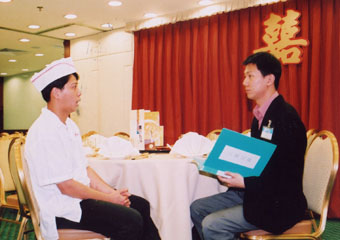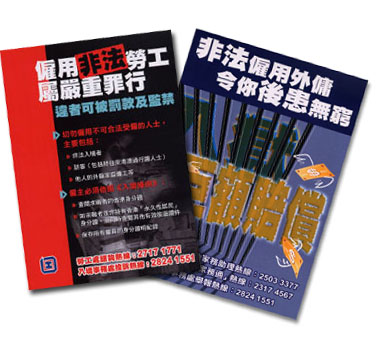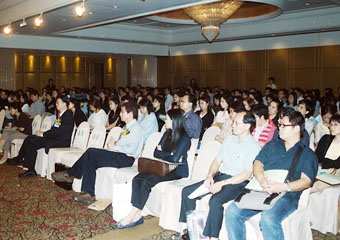Annual Report 2002
Chapter 6
Employee Rights and Benefits
The Programme of Employee Rights and Benefits6.1 The objective of the Employee Rights and Benefits Programme is to improve and safeguard employee rights and benefits in an equitable manner. Our aim is to progressively enhance employment standards in a way which is commensurate with the pace of Hong Kong's economic and social developments and to strike a reasonable balance between the interests of employers and employees. We achieve this by:
6.2 The principal legislation administered by this programme area includes the Employees' Compensation Ordinance (ECO), the Pneumoconiosis (Compensation) Ordinance (PCO), the Protection of Wages on Insolvency Ordinance (PWIO), the Employment Ordinance (EO) on conditions of employment and its subsidiary Employment of Children Regulations and Employment of Young Persons (Industry) Regulations, as well as Part IVB of the Immigration Ordinance.
6.3 The ECO establishes a no-fault, non-contributory employee compensation system under which individual employers are liable to pay compensation for work-related injuries or fatalities. The ordinance requires all employers to possess valid insurance policies to cover their liabilities under the ordinance and at common law.
6.4 The PCO provides compensation
to persons who suffer from silicosis or asbestosis.
Compensation is paid from the Pneumoconiosis Compensation
Fund, which is administered by the Pneumoconiosis Compensation
Fund Board.
6.5 The PWIO provides
for the establishment of the Protection of Wages on
Insolvency Fund (the Fund) and its administration by
a board. Under the PWIO, employees who are owed wages,
wages in lieu of notice and severance payments by their
insolvent employers may apply to the Fund within six
months after their last day of service for ex-gratia
payments.
6.6 The EO is the main
piece of legislation governing conditions of employment
in the non-government sector. The Employment of Children
Regulations made under the EO prohibit the employment
of children below the age of 15 in industrial undertakings
and regulate the employment of children aged 13 but
under 15 in non-industrial establishments. The Employment
of Young Persons (Industry) Regulations set out requirements
on the working time arrangements for young persons employed
in the industrial sector and prohibit their employment
in dangerous trades.
6.7 The Labour Department also administers Part IVB of the Immigration Ordinance to combat illegal employment in order to protect the employment opportunities of local workers.
Our Work and Achievements in 2002Key Indicators of Work 6.8 We stepped up our efforts to safeguard the rights and benefits of employees through various activities in 2002. Some key indicators of work of this programme area are shown in Figure 6.1.
Stepping Up Enforcement Against Wage Offences 6.9 The Labour Department
takes a serious view on late payment and underpayment
of wages and has put in place effective arrangements
to enforce statutory provisions governing payment of
wages. We conducted territory-wide blitz operations
and inspections to workplaces such as construction sites
and catering establishments to detect wage offences.
All suspected wage offences are investigated and prosecutions
are taken out once sufficient evidence is available.
6.10 With stepped-up enforcement action in 2002, the number of summonses heard in respect of wage offences rose to 198, representing a marked increase of 108 per cent over the 95 summonses in 2001. As for summonses convicted, the number was 139 for 2002 as against 75 in 2001, an increase of 85 per cent.
Legislative Proposals to Preserve and Improve Employee Benefits and their Progress 6.11 In 2002, the Employees Compensation Assistance Ordinance was amended to restore the long term financial viability of the Employees Compensation Assistance Scheme (ECAS).
6.12 In April 2002, we
introduced an amendment bill into the Legislative Council
to improve the benefits of employees who suffered from
noise-induced deafness by reason of their employment
in specified noisy occupations. The major proposals
included raising the minimum and maximum levels of compensation
in accordance with the rate of nominal wage increase,
revising upwards the percentage of permanent incapacity,
providing reimbursement of expenses for hearing assistive
devices, adding four new specified noisy occupations
and empowering the Occupational Deafness Compensation
Board to conduct or finance rehabilitation programmes.
6.13 During the year,
we consulted the Manpower Panel of the Legislative Council
on the proposal to recognise Chinese medicine under
the Employment Ordinance, Employees' Compensation Ordinance,
Pneumoconiosis (Compensation) Ordinance and the Pneumoconiosis
Ex-Gratia Scheme. The Panel agreed in principle to our
proposal. Drafting of the legislation for implementation
of the proposal has commenced.
Vigorous Enforcement Efforts 6.14 We have stepped up our enforcement efforts to ensure that the statutory rights of employees under labour legislation are well protected.
6.15 In 2002, labour inspectors
carried out 162 417 inspections to different economic
sectors, including 157 968 inspections to combat illegal
employment. Figure 6.2 We enhanced our communication
with the Immigration Department and the Police for more
effective exchange of intelligence and inter-departmental
enforcement operations. Special inspection campaigns
were conducted to workplaces and targeted trades where
illegal workers, including foreign domestic helpers
engaged in non-domestic duties, were more likely to
be found. Altogether 341 suspected illegal workers were
referred to the Immigration Department or the Police
in 2002 for follow-up actions.
6.16 We further strengthened
the monitoring of government service contractors to
protect the statutory rights of their workers. In 2002,
a dedicated enforcement team of labour inspectors was
deployed to check the employment conditions of low-skilled
workers engaged by the contractors through workplace
inspections and complaint investigations. A total of
393 inspections were conducted and 1 036 workers interviewed
in the year. Contractors found to have breached labour
legislation were prosecuted. We also assisted the procuring
departments in enhancing their monitoring measures in
the light of our enforcement experience.
6.17 To ensure compliance with the required conditions under the Supplementary Labour Scheme, we investigated 117 complaints and cases on suspected irregularities such as alleged displacement of local workers, underpayment of wages and deprivation of rest days or statutory holidays of imported workers.
Processing Employee Compensation Cases 6.18 Under the current no-fault employees compensation system, compensation is payable to injured employees or family members of deceased employees for any work-related injuries or deaths. Claims for compensation involving fatality are determined by the courts or the Commissioner for Labour under the improved settlement mechanism introduced in August 2000.
6.19 Information on the
employee compensation cases reported in 2002 was listed
in Figures 6.3 and 6.4. In
2002, we processed 36 567 non-fatal cases reported in
the year and involving sick leave exceeding three days.
This included 12 270 cases settled directly between
employers and employees. Compensation amounting to $7.97
million and $330 million was payable respectively to
the injured employees in minor cases and in cases involving
sick leave exceeding three days.
6.20 For the 57 019 employee compensation cases reported in 2001, 54 583 non-fatal cases with sick leave exceeding three days and 141 fatal cases were settled as at the end of 2002. A sum of $910 million was payable as compensation to the injured employees or family members of deceased employees. The number of days lost was 1 472 756. Figure 6.5
6.21 The Loan Scheme for Employees Injured at Work and Dependants of Deceased Employees provides temporary relief to victims of work accidents. Under the scheme, an interest-free loan up to $15,000 in each case will be made to eligible applicants. In 2002, a total loan of $346,859 was approved in 24 applications.
Partnership with Statutory Bodies 6.22 We maintain close partnership with various statutory bodies to administer schemes for the protection of the rights and benefits of employees.
Protection of Wages on Insolvency Fund Board 6.23 We support the Protection of Wages on Insolvency Fund Board by verifying applications and approving payments from the Fund. In 2002, we received a record high of 23 023 applications and processed 20 157 applications, leading to payments of $513.8 million. Relevant information was shown in Figures 6.6 and 6.7. As a result of the surge in the number of applications, the Fund's reserve depleted significantly in the year, and a government bridging loan of $695 million was arranged.
6.24 The department and
the Fund Board take a serious view on possible abuse
of the Fund, particularly with employers dishonestly
shifting their liabilities on wage payments to the Fund.
Stringent vetting procedures are in place to process
all applications. In November, an "inter-departmental
task force" comprising representative of the Labour
Department, Official Receiver's Office, Commercial Crime
Bureau of the Police Force and Legal Aid Department
was set up to further prevent possible abuse.
Pneumoconiosis Compensation Fund Board 6.25 The Pneumoconiosis Compensation Fund Board (PCFB) is established under the Pneumoconiosis (Compensation) Ordinance (PCO) to provide compensation to persons suffering from pneumoconiosis. The Board is financed by a levy collected from the construction and quarrying industries. Under the PCO, the Labour Department is responsible for determining whether the applicants are entitled to compensation. For those eligible persons, they will receive compensation in the form of monthly payments from the PCFB.
Employees Compensation Assistance Fund Board 6.26 The Employees Compensation Assistance Fund Board (ECAFB) is set up under the Employees Compensation Assistance Ordinance (ECAO). The ECAFB is responsible for running the Employees Compensation Assistance Scheme which provides payments to injured employees who are unable to receive their entitlements for employment-related injuries from their employers or insurers. The scheme also protects employers in the event of the insurers underwriting their employees' compensation insurance becoming insolvent.
Occupational Deafness Compensation Board 6.27 The Occupational
Deafness Compensation Board (ODCB) is established under
the Occupational Deafness (Compensation) Ordinance to
provide compensation to those persons who suffered from
noise-induced deafness due to employment in specified
noisy occupations.
Information and Advisory Services Telephone Enquiry Service 6.28 We operate a round-the-clock Telephone Enquiry Service (TES) to handle general enquiries on labour legislation and labour matters. In 2002, we added more topics to the TES for information retrieval by callers over telephone or via fax. Members of the public can now listen at any time to 80 topics of pre-recorded messages in Cantonese, Putonghua or English on labour legislation and services of the department. They can also obtain 94 forms and printed messages in Chinese or English by fax. During office hours, telephone enquiry officers are available to answer further enquiries. In the year, this highly popular service handled 1 266 039 calls. Figure 6.8
Briefings and Promotional Campaigns 6.29 In 2002, we arranged 4 briefings for the public sector and 61 briefings for imported workers and their employers to publicise the rights and obligations of the parties concerned.
6.30 Extensive publicity
campaigns were launched to educate employers and employees
about their rights and obligations under the Employees'
Compensation Ordinance.
|








